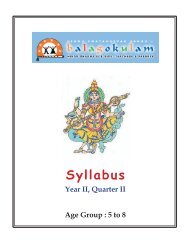Download pdf - Balagokulam
Download pdf - Balagokulam
Download pdf - Balagokulam
Create successful ePaper yourself
Turn your PDF publications into a flip-book with our unique Google optimized e-Paper software.
December<br />
Hindu Dharma<br />
India’s Contribution to the Metallurgy<br />
Metallurgy, the practice of separating metals from their ore and refining<br />
them into pure metals. In India, metallurgy developed into a science that<br />
made use of high refinement and precision techniques to extract metals and<br />
form different mixtures of metals (alloys) to prepare objects to be used for<br />
different aspects of day-to-day activities.<br />
Ancient Sanskrit texts contain various references to the use of metals.<br />
The Rigveda mentions ayas (metals), the Yajurveda and Atharvaveda have<br />
references to smiths (skilled metal workers) as well as the smelting process.<br />
<br />
<br />
<br />
28<br />
The techniques of using metallic<br />
tools for agriculture and minting<br />
coins developed thousands of<br />
ears ago in ancient India.<br />
Metals were used to create<br />
images, statues and artistic<br />
items like lamps in ancient<br />
India.<br />
The famous iron pillar at New<br />
Delhi, which is 7.32 meters<br />
tall and made of 98% wrought<br />
iron, was constructed by<br />
Vikramaditya almost 1600<br />
years ago around the 5th<br />
century BC. This iron pillar is<br />
a glowing example of the high<br />
skill level of Indian craftsmen<br />
of those times because it<br />
has withstood dust, extreme<br />
weather and rust for more than<br />
Hindu Swayamsevak Sangh (HSS)
















